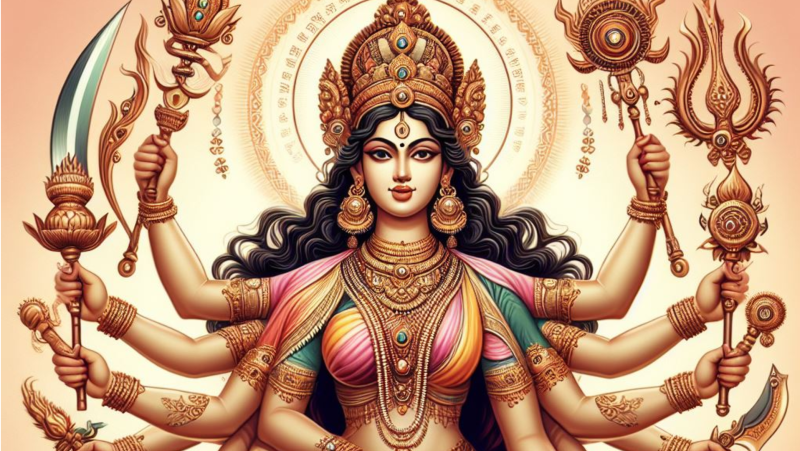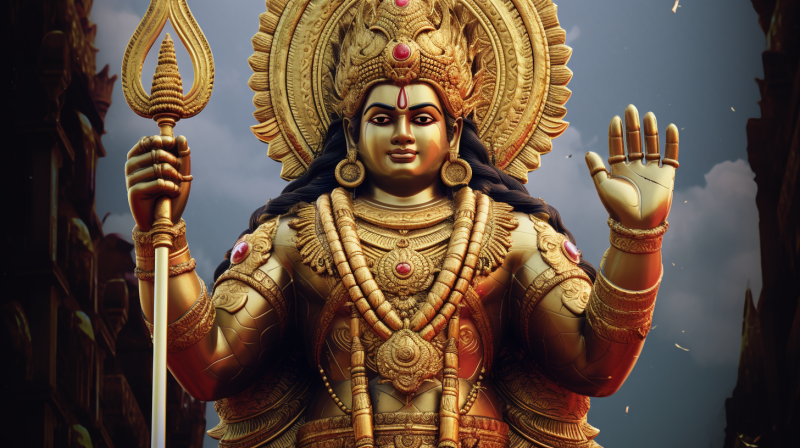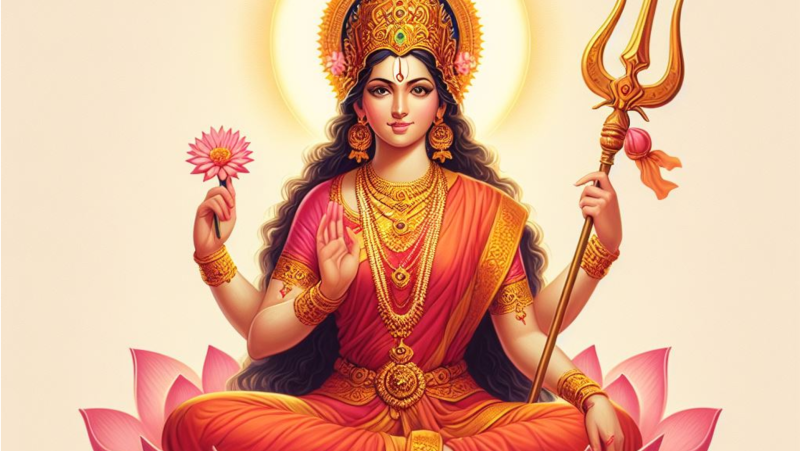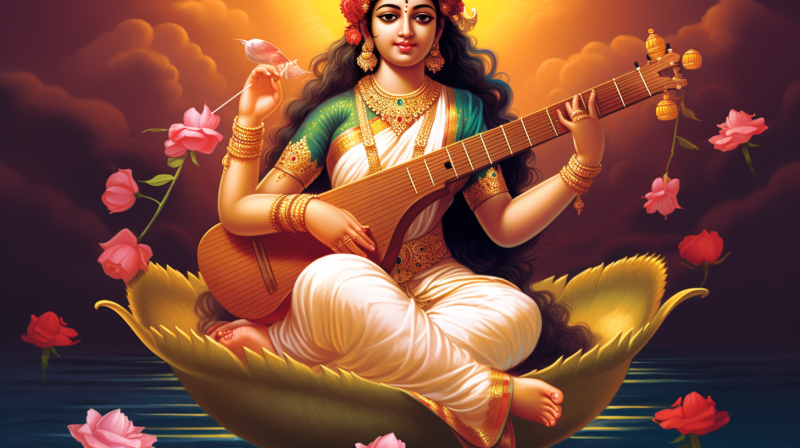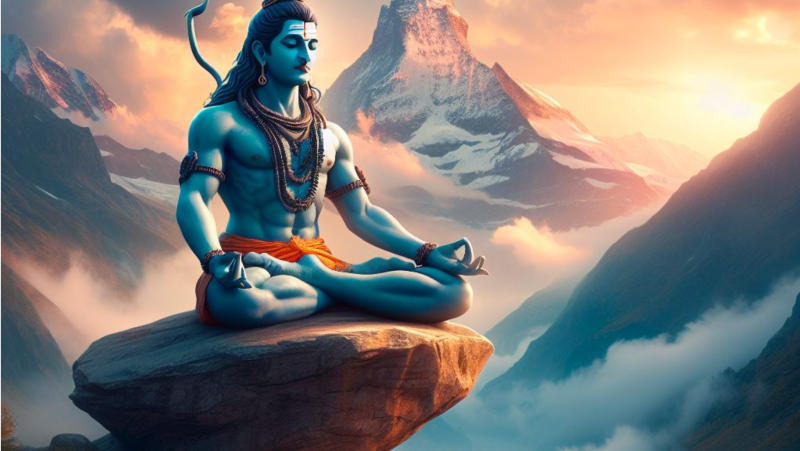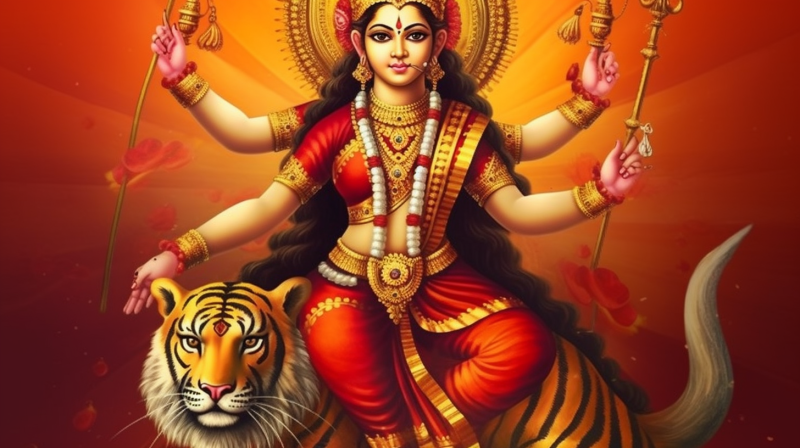
Goddess Durga, often referred to simply as "Ma Durga," is a prominent and revered deity in Hinduism. She is particularly celebrated during the festival of Navaratri, which lasts for nine nights and honors her victory over the buffalo demon Mahishasura.
Goddess Durga is a prominent deity in Hinduism and is highly revered throughout India and other parts of the world where Hinduism is practiced. She is a symbol of divine feminine power, strength, and protection. The mythology and origins of Goddess Durga are rooted in Hindu scriptures and legends, particularly in the epic narratives of the Devi Mahatmya and the Puranas. Here's a detailed overview of Goddess Durga:
Goddess Durga Origin
According to Hindu mythology, Goddess Durga was created by the combined energies and divine powers of the trinity of Hindu gods: Brahma (the creator), Vishnu (the preserver), and Shiva (the destroyer). The story goes that a demon named Mahishasura had gained immense power and began wreaking havoc on the heavens and earth. The gods realized that they were unable to defeat him individually, so they combined their energies to create a supremely powerful goddess, Durga, who would vanquish Mahishasura and restore cosmic order.
Goddess Durga Mythology
The most well-known narrative featuring Goddess Durga is found in the text called the Devi Mahatmya, also known as the Durga Saptashati or Chandi Patha. This text is part of the Markandeya Purana and is dedicated to the glorification of the goddess. It narrates the story of Durga's battle against the demon Mahishasura and her subsequent victory.
In the story, Mahishasura had received a boon from Lord Brahma, which made him virtually indestructible by any male deity. Armed with this boon, he began to terrorize the universe. Unable to tolerate his tyranny, the gods combined their energies to create Goddess Durga, who possessed immense power and was equipped with various weapons and tools given by different gods.
The battle between Durga and Mahishasura raged for nine days and nights. On the tenth day, known as Vijaya Dashami or Dussehra, Goddess Durga defeated and vanquished Mahishasura, symbolizing the triumph of good over evil. This victory is celebrated with great fervor in the festival of Durga Puja, which takes place annually in various parts of India.
Goddess Durga Symbolism and Attributes
Goddess Durga is rich in symbolism and possesses various attributes that carry deep spiritual and philosophical meanings. Each aspect of her iconography and symbolism reflects her divine qualities, her role as a protector, and her representation of cosmic forces. Here are some of the key symbols and attributes associated with Goddess Durga:
A. Lion or Tiger: Goddess Durga is often depicted riding a lion or a tiger. The lion represents power, strength, and fearlessness. It symbolizes the goddess's dominance over both the animal kingdom and the human realm, signifying her control over both physical and spiritual forces.
B. Ten Arms: One of the most distinctive features of Goddess Durga's iconography is her ten arms. Each arm holds a different weapon, symbolizing her various powers and attributes. The ten arms also represent her ability to protect her devotees from all directions and to simultaneously address multiple challenges.
C. Weapons: The various weapons held by Durga in her hands carry specific symbolic meanings:
• Trishula (Trident): Represents control over the three gunas (attributes) of nature – Sattva (purity), Rajas (passion), and Tamas (ignorance).
• Chakra (Discus): Symbolizes the cycle of time and the eternal cosmic law.
• Sword: Represents knowledge and discrimination to cut through ignorance.
• Bow and Arrow: Symbolize energy, concentration, and focus.
• Conch Shell: Represents the sound of the universe and the divine Om.
• Mace: Symbolizes power and authority.
• Lotus: Signifies purity and spiritual growth.
• Sudarshana Chakra: A spinning disc-like weapon associated with Lord Vishnu, symbolizing protection and destruction of evil forces.
D. Third Eye: Goddess Durga is often depicted with a third eye on her forehead, which represents her intuitive and spiritual insight. This eye can see beyond the physical realm into the deeper truths of existence.
E. Red Clothing: Durga is often depicted wearing red clothing, which symbolizes her power and fierceness. Red is also associated with life force, vitality, and passion.
F. Divine Feminine Energy: Goddess Durga is a manifestation of divine feminine energy or Shakti. She represents the creative, nurturing, and sustaining aspects of the universe. Her portrayal reminds us of the significance of feminine power and its role in maintaining balance and harmony.
G. Battle with Mahishasura: The story of Durga's battle with the demon Mahishasura symbolizes the eternal struggle between good and evil, light and darkness. Durga's victory signifies the triumph of righteousness and the eventual restoration of cosmic order.
H. Navaratri Festival: The nine-day festival of Navaratri celebrates Goddess Durga's nine manifestations or forms, each of which represents different aspects of her power. It is a time of devotion, fasting, and celebration, emphasizing the importance of spiritual growth and inner purification.
In essence, Goddess Durga's symbolism and attributes convey her multifaceted nature as a fierce protector, a compassionate nurturer, and the embodiment of divine energy. Her iconography serves as a reminder of the cosmic forces at play in the universe and the eternal struggle between good and evil.
Goddess Durga Forms and Avatars
Goddess Durga is worshiped in various forms and avatars, each representing different aspects of her divine power and qualities. These forms and avatars highlight her versatility and her ability to address different needs and challenges faced by her devotees. Here are some of the prominent forms and avatars of Goddess Durga:
A. Parvati: Parvati is the gentle and nurturing form of Durga. She represents love, beauty, and motherhood. Parvati is often depicted as a loving wife and mother, and she is associated with fertility, marital bliss, and domestic harmony.
B. Kali: Kali is one of the fiercest forms of Durga. She is often depicted with a dark complexion and a fierce expression. Kali is the embodiment of raw power, destruction of evil, and the cosmic energy of time. She is often shown standing on Lord Shiva, symbolizing the dynamic interplay between creation and destruction.
C. Ambika: Ambika is a form of Durga that represents the nurturing and protective aspects of motherhood. She is often depicted with multiple arms, holding various weapons and items to symbolize her protective nature. Ambika is seen as a source of guidance and support for her devotees.
D. Annapurna: Annapurna is the goddess of nourishment and abundance. She is often depicted holding a bowl of food, symbolizing her role in providing sustenance and nourishment to all beings. Worshiping Annapurna is a way to seek blessings for an abundant and fulfilling life.
E. Chandi or Chandika: Chandi is a form of Durga that embodies her warrior aspect. She is fierce, determined, and ready to battle evil forces. Chandi is often associated with the Devi Mahatmya, where she defeats the demon Mahishasura. This form emphasizes Durga's power to overcome challenges and protect her devotees.
F. Skandamata: Skandamata is the mother of Lord Kartikeya (Skanda/Murugan), the war god. She is depicted holding her infant son in her lap. This form represents motherly love and protection. Skandamata signifies the bond between a mother and child and is revered as a source of maternal blessings.
G. Katyayani: Katyayani is a form of Durga worshiped for her courage and valor. She is often depicted as a warrior goddess riding a lion, holding weapons in her multiple hands. Katyayani is believed to help devotees overcome obstacles and difficulties.
H. Saraswati: While Saraswati is primarily considered a separate goddess of knowledge, music, and arts, she is sometimes seen as an aspect of Durga. As such, she embodies the intellectual and creative aspects of the divine feminine.
I. Maha Gauri: Maha Gauri is the goddess of purity and spirituality. She is often depicted as serene and compassionate. Her name "Maha Gauri" translates to "extremely white," symbolizing her purity and spiritual brilliance.
J. Siddhidatri: Siddhidatri is the goddess of divine knowledge and spiritual realization. She is often depicted surrounded by sages and seekers, granting them the blessings of wisdom and enlightenment.
These are just a few of the many forms and avatars of Goddess Durga. Each form highlights a specific facet of her divine nature and showcases her ability to fulfill various roles in the lives of her devotees. Worshipping these different forms allows devotees to connect with the specific attributes they seek to invoke or receive blessings from.
The Nine Forms of Durga (Navadurga)
The Navadurga, or the Nine Forms of Goddess Durga, are a group of nine distinct manifestations of the goddess. These forms are worshiped during the nine nights of Navaratri, a major Hindu festival dedicated to the divine feminine. Each form of Navadurga represents different facets of power, strength, and devotion, and each form is associated with a particular day of Navaratri. Here are the Nine Forms of Durga:
• 1. Shailaputri: On the first day of Navaratri, Shailaputri is worshiped. She is depicted as a young woman holding a trident and riding a bull. "Shaila" means mountain, and "Putri" means daughter. She is the daughter of the Himalayas and represents the essence of the mountains—strength, stability, and grace.
• 2. Brahmacharini: Brahmacharini is worshipped on the second day. She is depicted as a meditative ascetic, holding a rosary and a water pot. This form symbolizes dedication, penance, and self-discipline. "Brahmacharini" represents the pursuit of knowledge and spiritual wisdom.
• 3. Chandraghanta: Chandraghanta is worshipped on the third day. She is depicted with a crescent moon on her forehead and riding a lion. This form represents bravery and grace and is a symbol of protection and warding off negative energies. She signifies courage in the face of adversity.
• 4. Kushmanda: On the fourth day, Kushmanda is worshiped. She is depicted as radiant and often shown with multiple arms, holding various weapons and items. The name "Kushmanda" means "creator of the universe," and she is believed to have created the cosmos with her divine smile.
• 5. Skandamata: Skandamata is the form worshipped on the fifth day. She is depicted holding her infant son, Lord Kartikeya (Skanda), in her lap. This form represents the nurturing aspect of motherhood and highlights the bond between a mother and her child.
• 6. Katyayani: Katyayani is worshipped on the sixth day. She is portrayed as a fierce warrior goddess riding a lion and wielding weapons. This form symbolizes courage and determination, and she is believed to protect her devotees from harm.
• 7. Kalaratri: On the seventh day, Kalaratri is worshipped. She is depicted as a dark and fierce form, with wild hair and a terrifying appearance. This form represents the destroyer of darkness and ignorance, as well as the conquering of fear.
• 8. Mahagauri: Mahagauri is worshipped on the eighth day. She is depicted as a calm and radiant goddess dressed in white. This form symbolizes purity, peace, and spiritual enlightenment. "Maha Gauri" means "extremely white," reflecting her pristine nature.
• 9. Siddhidatri: Siddhidatri is worshipped on the ninth day of Navaratri. She is depicted surrounded by celestial beings, bestowing blessings of spiritual knowledge and realization. "Siddhidatri" represents the giver of spiritual and mystical powers.
Worshiping these Nine Forms of Durga during Navaratri is a way to honor the various qualities of the divine feminine and seek blessings for strength, wisdom, and spiritual growth. Each form reflects a unique attribute of Goddess Durga and holds significance for devotees seeking different forms of blessings and guidance.
Goddess Durga And Navaratri Festival
Navaratri, meaning "nine nights," is a major Hindu festival dedicated to the worship of Durga and her various forms. The festival is celebrated with devotion, fasting, prayers, music, dance, and cultural events. It culminates in Dussehra, a day that marks the victory of Durga over Mahishasura and the defeat of evil forces.
Durga Puja
Durga Puja is a grand celebration dedicated to Goddess Durga and is one of the most significant festivals in India, especially in West Bengal. It usually takes place over a period of ten days, with elaborate rituals, cultural performances, and artistic displays. The festival culminates in Vijayadashami or Dussehra, when idols of Durga are immersed in water as a symbol of her return to her divine abode.
Goddess Durga Iconography
Ma Durga is often depicted with ten arms, each holding a different weapon, including a sword, bow, arrow, trident, and more. She is also shown with a third eye on her forehead, symbolizing her divine insight. The lion or tiger she rides signifies her dominion over both the animal kingdom and the human realm.
Worship of Goddess Durga
Worship of Goddess Durga is an integral part of Hinduism, and there are numerous temples dedicated to her across India and other parts of the world where Hinduism is practiced. The worship of Durga involves a combination of rituals, prayers, offerings, and devotional practices. Here's an overview of the worship of Goddess Durga and some famous temples dedicated to her:
Worship of Goddess Durga can vary in its practices, but it generally involves the following aspects:
1. Daily Puja: Many devotees perform daily puja (ritual worship) to Goddess Durga in their homes or designated prayer spaces. This includes lighting incense, offering flowers, chanting hymns and mantras, and performing arati (waving of lamps) to invoke her presence.
2. Festivals: Apart from Navaratri, there are several other festivals dedicated to Goddess Durga. Some of the most notable ones include Durga Puja in West Bengal, Kali Puja, and Vijaya Dashami (celebrated at the end of Navaratri).
3. Special Offerings: Devotees offer various items to Goddess Durga as a symbol of their devotion and gratitude. These offerings may include fruits, sweets, coconuts, sindoor (vermillion), bangles, and traditional attire.
4. Mantras and Hymns: Recitation of specific mantras and hymns dedicated to Durga is an important aspect of worship. The most famous mantra associated with her is the "Durga Gayatri Mantra."
Durga Mandir & Durga Temples
Temples dedicated to Goddess Durga are found throughout India and in regions with a significant Hindu population. The most famous Durga temple is the Kali Temple at Kalighat in Kolkata, which attracts numerous devotees, some notable temples are Kamakhya Temple in Assam, Vaishno Devi Temple in Jammu and Kashmir. During Navaratri, elaborate rituals and ceremonies are performed in her honor, and her various forms are celebrated with devotion.
Goddess Durga Spiritual Significance
The spiritual significance of Goddess Durga is profound and multifaceted. She represents the divine feminine energy and embodies various qualities and aspects that hold great spiritual meaning for devotees. Here are some key spiritual significances of Goddess Durga:
A. Divine Feminine Energy (Shakti): Goddess Durga symbolizes the primordial divine feminine energy, known as Shakti. She is the source of creation, preservation, and destruction, encompassing the entire cycle of life. Her portrayal reminds devotees of the inherent power and energy within all aspects of existence.
B. Unity of All Divine Forces: Goddess Durga is often depicted with multiple arms, each holding a different weapon or object. These arms represent the various divine forces that come together to form a unified source of strength. This unity signifies that all divine attributes ultimately stem from the same divine source.
C. Overcoming Evil and Darkness: The mythological story of Durga's battle with the demon Mahishasura symbolizes the triumph of good over evil and light over darkness. This narrative serves as a reminder that divine power can overcome all obstacles and negativity, both within the external world and within oneself.
D. Balancing Spiritual and Material Realms: Goddess Durga's role as both a fierce warrior and a nurturing mother represents the balance between the spiritual and material aspects of life. This duality teaches devotees the importance of balancing one's responsibilities and duties with their spiritual pursuits.
E. Inner Strength and Courage: Devotees turn to Goddess Durga for inner strength, courage, and resilience. Her fierce demeanor and battle against powerful demons illustrate the strength required to face challenges in life. She inspires individuals to overcome their fears and obstacles with determination.
F. Protection and Divine Guidance: Goddess Durga is often referred to as the Divine Protector. Devotees seek her blessings for protection from negative forces, both physical and spiritual. They believe that invoking her presence can create a shield of positive energy around them.
G. Overcoming Ego and Ignorance: Goddess Durga's battle with Mahishasura signifies the struggle against ego and ignorance. Mahishasura's ego led to his downfall, and Durga's victory illustrates the need to transcend the limitations of the ego and recognize the divine truth within.
H. Inner Transformation: The worship of Goddess Durga during Navaratri involves introspection and self-purification. Devotees seek to transform their inner selves by invoking the qualities represented by each of her forms, such as courage, wisdom, and compassion.
I. Connection to Cosmic Forces: Goddess Durga's representation of cosmic forces emphasizes the interconnectedness of all beings in the universe. Her presence reminds devotees of their connection to the larger cosmic order and their place within it.
In essence, the spiritual significance of Goddess Durga goes beyond her mythological stories and iconography. She serves as a powerful symbol of the divine energy that sustains and guides the universe, inspiring individuals to tap into their inner strength, seek spiritual growth, and align themselves with the greater cosmic harmony.
You may also like …
Are You The Proud Hindu?
The Trimurti
Create an account to join us and start taking part in conversations.
SIGNIN